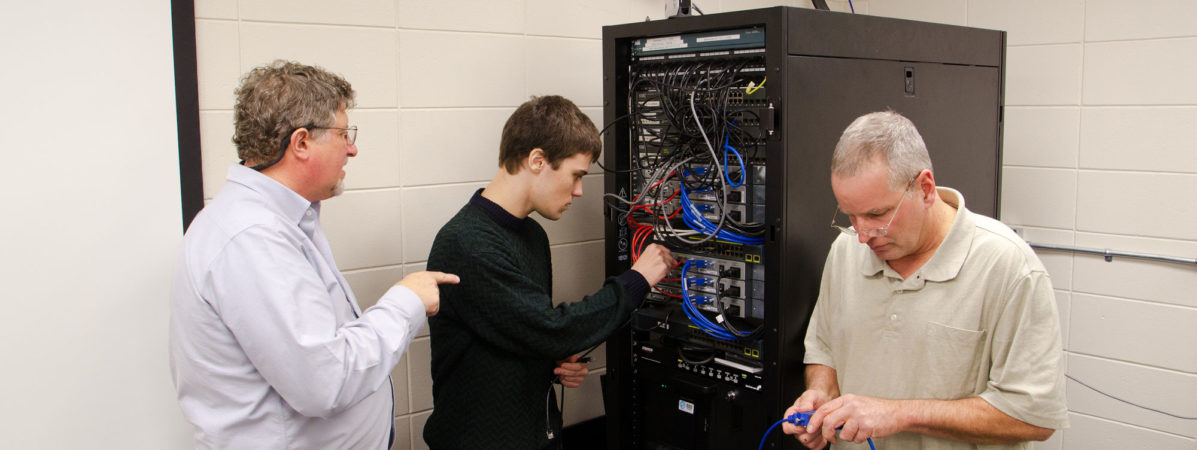
For the communities that surround PTCC, there is also a socio-economic distance that cycles of poverty put before many potential students, which can cause a psychological distance that keeps people from attempting a college education. What makes PTCC a Beacon community for adult education is how it uses technology to break down these types of distances for thousands of students in East Central Minnesota, thus connecting them to new educational and employment opportunities.
An example of the kind of student PTCC seeks to help is Edwin, a student machinist who is coming to college for the first time in his mid-40s. According to Edwin, “I tried with school before, but I don’t know. I just needed to work, and then when I got laid off for the fourth time, I came here, and I felt like I could do the college thing for the first time.” This is no accident. The school has a lot of students like Edwin, and it looks for ways to meet them where they are by breaking down any psychological distance they might face due to a lack of confidence in their academic abilities.
One sees this in PTCC’s recent pilot program for students in the Advanced Manufacturing Technology program (which Edwin is part of). For those students who might be struggling academically, classes are taught by two instructors — one who covers the technical content of the class, while a second breaks down some of the basic academic skills that the class requires. Good pedagogy alone, like that which is on display here, is vital to helping under-skilled adult students make the jump into college. But it is worth noting that many PTCC students are looking to get into highly technical jobs, which means that the staff at the college have to not only be good at teaching students like Edwin, they also have to be good at bringing cutting edge technology into the classroom.
PTCC President Robert Musgrove has aggressively sought federal grants from the Department of Labor to bring that kind of technology to PTCC. As a result of his staff’s efforts, the college offers state-of-the-art technology that includes a prototyping lab with a 3D printer and a machining lab for manufacturing students, as well as lifelike patient simulators for nursing students that are programmed to present real scenarios.
The technology PTCC offers is on par with much larger institutions, and walking around with staff, you can see their pride as they show off one lab after another. But, an even more impressive use of tech to combat students’ physical distance is being used by the college to give students in the community educational opportunities they would not have otherwise.
To counter the deficit of IT professionals in rural areas like Pine City, the college has joined three partner schools to create Teaching in the Cloud, a program that gives students access to a virtualization hub that can teach them all aspects of cloud computing, from basic database management to dealing with cybersecurity attacks. Speaking with Ken Ries, PTCC’s CIO, one gets a feeling for the school’s ambitions: “There’s no reason why our students shouldn’t get exposed to the same kind of tech that they would if they were at a big four-year institution.”
“A potential student might dig out from several feet of snow and drive to his job (if he has one), but often there is not enough time in the day to do that and get to class. And if the person has kids, it’s impossible,” said Stefanie Schroeder, PTCC’s Dean of Workforce and Economic Development. Schroeder is keenly aware of the needs of her students; she grew up a few miles from campus and has spent the better part of two decades working in the non-profit sector helping to alleviate poverty in the area. Driving to a partner manufacturing plant that is allowing her students to take part in classes at their desks via teleconferencing, she told us that “it’s not unheard of for students to travel 60, 70, 80 miles each way for work. Anywhere, that would be difficult. But when you consider that the people who live here might be snowed-in six months of the year, that distance goes beyond inconvenience.”
To reach some of those individuals, PTCC has partnered with employers in the region to develop a series of credit-bearing courses delivered via teleconferencing software that students can access while at work. In essence, PTCC has created mini-MOOCs (massive open online courses) for over 300 workers from 38 different companies, with the goal of giving those employees more education and training that will lead to credentials in their fields and better paid work.
The list of how this small college in Minnesota uses tech to break down the isolation of its rural surroundings is long and varied. What is consistent throughout everything done by the staff members at Pine Technical & Community College is a constant vigilance for the next step, and finding new and better ways to remove obstacles for their students to move forward in their lives.